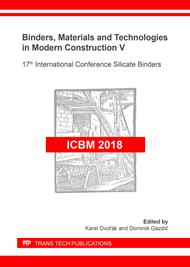p.3
p.9
p.15
p.21
p.27
p.35
p.41
p.47
The Influence of Raw Meal Granulometry on the Formation and Properties of Clinker
Abstract:
Cement production belongs to the most important branch of industry. It is marked out by processing of great quantity of natural raw materials and of considerable energetic demand. Not only the intensification of the contemporary production processes is the permanent effort of the cement industry, but also the search for new energy less demanding methods. The paper is focused on one of the most important components of the intensification of cement production – on the preparation of raw meal. It mainly deals with the influence of granulometry and microhomogeneity of the input raw materials on the quality and economy of the process of production and on the final product. The study was carried out mainly by methods of optical microscopy and the determination of technological parameters of cements. It has been found that a change in granulometry of raw meal has a significant impact on the formation rate of the clinker phases. Subsequently, the grindability of the clinker and the strength of the cement are influenced, especially in the short-term hydration. Change of granulometry and homogeneity of raw meal can greatly optimize the quality and economy of the cement production process.
Info:
Periodical:
Pages:
9-14
Citation:
Online since:
August 2019
Authors:
Keywords:
Price:
Сopyright:
© 2019 Trans Tech Publications Ltd. All Rights Reserved
Share:
Citation:


